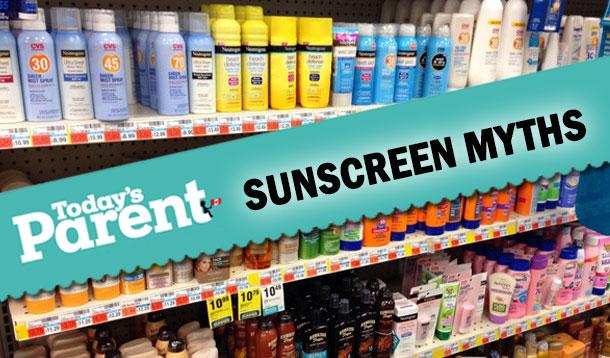
I read an article today published by Today's Parent about sunscreen myths.
At this time of year, there are going to be a lot of articles about summer sun safety and how to use sunscreens. Of course, there will also be a lot of incorrect information in these articles.
This is the first article of the season that I have read, so let me break down the information for you:
The article states (I have edited for space, but you can read the whole article by clicking the link above):
![]() "Fiction: SPF 15 provides enough coverage for your skin.
"Fiction: SPF 15 provides enough coverage for your skin.
Everyone should be wearing at least SPF 30 . . . Keep in mind that SPF only refers to protection from UVB rays, so you need to look for the phrase “broad spectrum” on the bottle, which means it also protects against UVA rays, shielding your skin from sunburn and the aging effects of deep-tissue skin damage."
This is not completely accurate!
SPF 15 will protect against 95% of UVA and UVB rays, while SPF 30 will protect against 96% of UVA and UVB rays. The difference in protection is not the amount of rays being blocked, but the duration of time the rays are being blocked. SPF 15 will work, under normal use, for about 80 minutes. SPF 30 will work, under the same conditions, for 120 minutes. Also, the issue of UVA and UVB protection does not factor into the equation in Canada. As of 2012, Health Canada required all sunscreens sold in Canada to offer broad spectrum protection. In the US this is not the case.
![]() "Fact: you should pitch that old tube of sunscreen.
"Fact: you should pitch that old tube of sunscreen.
Most brands have a shelf life of three years, but once opened, sunscreen begins to degrade."
This is true!
All sunscreens are required to clearly label the expiration date on the packaging. Check sunscreens before using them and discard any that have expired.
![]() "Fiction: Once you’ve applied sunscreen, you’re all set for the day.
"Fiction: Once you’ve applied sunscreen, you’re all set for the day.
To avoid a burn, it’s important to reapply sunscreen to all exposed skin throughout the day."
Also true!
Sunscreens only work for a maximum of 2 hours with normal use (i.e. day to day activities). With extreme use (sports, swimming, any activity that induces perspiration), most sunscreens will break down in about 40 minutes. Reapply often.
![]() "Fact: Your lips and ears are at HIGH risk of skin cancer.
"Fact: Your lips and ears are at HIGH risk of skin cancer.
Lips and ears are two of the most common areas where melanoma occurs because they’re often forgotten during sunscreen applications."
True!
Skin is skin and all skin requires protection from UV exposure. The back of the neck is another area people often overlook.
![]() "Fiction: If your makeup has SPF you don’t need to use sunscreen.
"Fiction: If your makeup has SPF you don’t need to use sunscreen.
. . . . You’re likely not applying them evenly or heavily enough to provide maximum protection."
This is great information!
I have written about this before. Sunscreen in makeup and skin care products is a marketing tool at best. In order to actually have the level of protection that an SPF rating indicates, you need to apply a layer of product that is 4mm thick on your skin. For your face, that is about 30mL for the entire body. Let's think of this another way—an adult should actually be using 25-50% of a 240mL tube of sunscreen if enjoying a full day at the beach (I personally say stay out of the sun). It is unlikely anyone applies that much skin care or makeup every day. Also, you need to reapply frequently, so it is just as unlikely you would reapply expensive foundation or moisturizer throughout the day.
Overall, great article with quite accurate information. Spread the word!
Check out this year's Top 3 Best Natural Sunscreens, and these Sun Myths and Facts For The Whole Family.